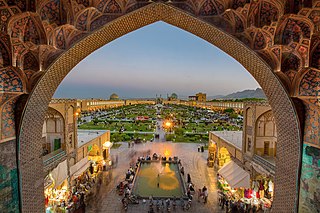
Isfahan, from its ancient designation Aspadana and, later, Spahan in middle Persian, rendered in English as Ispahan, is a major city in the Greater Isfahan Region, Isfahan Province, Iran. It is located 406 kilometres south of Tehran and is the capital of Isfahan Province. The city has a population of approximately 1.9 million, making it the third-largest city in Iran, after Tehran and Mashhad, and the second-largest metropolitan area.

The Golestan Palace, also known as the Gulistan Palace and sometimes known as the Rose Garden Palace, is the former royal Qajar complex in Iran's capital city, Tehran.

Kashan is a city in the northern part of Isfahan province, Iran. At the 2017 census, its population was 396,987 in 90,828 families.

Iranian architecture or Persian architecture is the architecture of Iran and parts of the rest of West Asia, the Caucasus and Central Asia. Its history dates back to at least 5,000 BC with characteristic examples distributed over a vast area from Turkey and Iraq to Uzbekistan and Tajikistan, and from the Caucasus to Zanzibar. Persian buildings vary from peasant huts to tea houses, and garden pavilions to "some of the most majestic structures the world has ever seen". In addition to historic gates, palaces, and mosques, the rapid growth of cities such as the capital Tehran has brought about a wave of demolition and new construction.

Ali Qapu Palace or the Grand Ālī Qāpū is an imperial palace in Isfahan, Iran. It is located on the western side of the Naqsh-e Jahan Square, opposite to Sheikh Lotfollah Mosque, and had been originally designed as a vast portal entrance to the grand palace which stretched from the Naqsh-e Jahan Square to the Chahar Baq Boulevard. The palace served as the official residence of Persian Emperors of the Safavid dynasty. UNESCO inscribed the Palace and the Square as a World Heritage Site due to its cultural and historical importance. The palace is forty-eight meters high and there are six floors, each accessible by a difficult spiral staircase. In the sixth floor, Music Hall, deep circular niches are found in the walls, having not only aesthetic value, but also acoustic. Ālī Qāpū is regarded as the best example of Safavid architecture and a symbol of Iran's Islamic heritage.
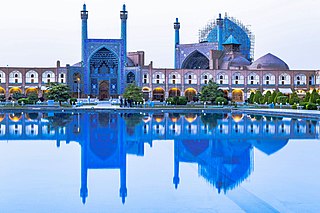
The Shah Mosque is a mosque located in Isfahan, Iran. It is located on the south side of Naghsh-e Jahan Square. It was built during the Safavid dynasty under the order of Shah Abbas I of Persia.
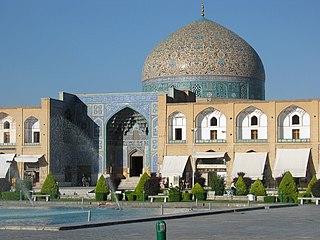
Sheikh Lotfollah Mosque is one of the masterpieces of Iranian architecture that was built during the Safavid Empire, standing on the eastern side of Naqsh-i Jahan Square, Esfahan, Iran. Construction of the mosque started in 1603 and was finished in 1619. It was built by the chief architect Mohammadreza Isfahani, during the reign of Shah Abbas I of Persia. On the advice of Arthur Upham Pope, Reza Shah Pahlavi had the mosque rebuilt and repaired in the 1920s.
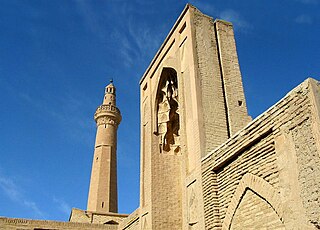
Nain is a city and capital of Nain County, Isfahan Province, Iran. At the 2011 census, its population was 25,379 in 7,730 families.

Hadi Sabzavari or Hajj Molla Hadi Sabzavari was an Iranian philosopher, mystic theologian and poet.

The Jāmeh Mosque of Isfahān or Jāme' Mosque of Isfahān, also known as the Atiq Mosque and the Friday Mosque of Isfahān, is a historic congregational mosque (Jāmeh) of Isfahan, Iran. The mosque is the result of continual construction, reconstruction, additions and renovations on the site from around 771 to the end of the 20th century. The Grand Bazaar of Isfahan can be found towards the southwest wing of the mosque. It has been a UNESCO World Heritage Site since 2012. It is one of the largest and most important monuments of Islamic architecture in Iran.

The Imam Reza shrine in Mashhad, Iran, is a complex which contains the mausoleum of Imam Reza, the eighth Imam of Twelver Shias. It is the largest mosque in the world by area. Also contained within the complex are the Goharshad Mosque, a museum, a library, four seminaries, a cemetery, the Razavi University of Islamic Sciences, a dining hall for pilgrims, vast prayer halls, and other buildings.
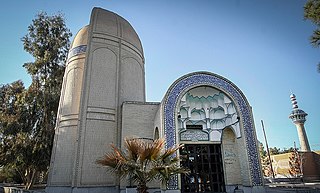
Takht-e Foulad is a historical cemetery in Isfahan, Iran. The cemetery is at least 800 years old. In the 13th century in the Ilkhanid era Takht-e Foulad was the most important cemetery in Isfahan and all of the famous personalities have a mausoleum in this cemetery. Unfortunately all of the mausoleums from the Ilkhanid era, except Baba Rokn ed-Din mausoleum, which is the oldest structure in Takht-e Foulad, have been destroyed. In the Safavid era there were 400 mausoleums in Takht-e Foulad, but there are now only 8 mausoleums from the Safavid era. In the Qajar era a large part of the cemetery was destroyed, but the cemetery hasn't lost its importance and by the end of Pahlavi era it was the most important cemetery in Isfahan. There are 20 structures from the Qajar era and 17 structures from the Pahlavi era in the cemetery. Before the Safavid age the cemetery had been known as Lessan ol-Arz and Baba Rokn ed-Din, but from the Safavid age until now its name is Takht-e Foulad.
Saint Mary Church of New Julfa is a historical Armenian church in Isfahan, Iran, completed in 1613.
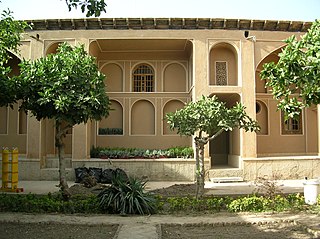
The Qazvinis' House is a historical house in Isfahan, Iran. It belongs to the age of Naser al-Din Shah Qajar.
The Alam's house is a historical house in Isfahan, Iran. The owner of the house was one of the Qajar aristocrats. The house has a yard, which is surrounded from every side by residential parts. The northern part is distinguished by a columned veranda and has a reception hall. There are two rooms on the two sides of the reception hall. In this hall, there are stucco and decorations with cut mirrors. The hall faces to veranda by seven sash windows and leads to the rooms by khatamkari doors. The southern part of the house is a narrow and long dining room, which has painted windows. Eastern and western parts have identical plans. Both of them have reception halls, which lead to the smaller rooms. All parts of the house have been decorated by brickwork, tiles, stucco and gilding. The limpid water in the stone howz in the middle of the yard reflects the beauty of the house.

The Museum of Contemporary Art is a contemporary art museum in Isfahan, Iran, located next to the Museum of Natural History.

The following is a timeline of the history of the city of Isfahan, Iran.

Deir-e Gachin Caravansarai is one of the greatest caravansarais of Iran which is located in the center of Kavir National Park. Its unique qualities is the reason it is called “Mother of Iranian Caravansarais”. It is located in the Central District of Qom County, 80 kilometers north-east of Qom and 35 kilometers south-west of Varamin. This monument was registered in Iran's National Heritage List on September 23, 2003. The structure of this caravanserai belongs to Sasanian era, and restorations took place in Seljuk, Safavid and Qajar eras. Its current form belongs to Safavid era. This caravanserai is situated on the ancient rout from Ray to Isfahan.
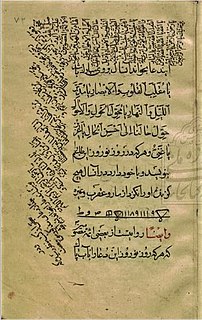
Mullah Mohammad Jafar Sabzevari was one of the Iranian scholars and clerics of the 12th century AH, the Imam of Friday Prayer of the Shah Mosque in Isfahan and the author of several books and treatises including "Nowruznameh" and "Ma'ad" which was compiled at the request of Shah Sultan Hussein Safavid.
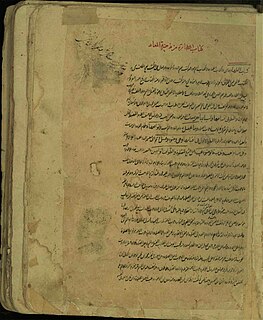
Mohammad Bagher Sabzevari known as Mohaghegh Sabzevari was an Iranian Faqih and Shiite scholar from the 11th century AH, Shaykh al-Islām and the Imam of Friday Prayer of Isfahan.





















